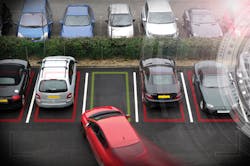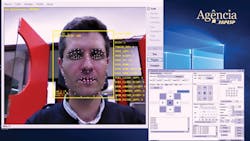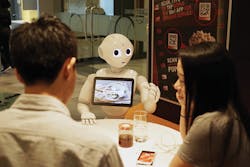July-August 2016 snapshots: Multispectral imaging, smart parking system, 3D imaging, robotic waitress
Researchers develop multispectral camera based on tilted mirrors
Multispectral imaging systems currently on the market use optics, materials, and components individually adapted for various spectral ranges. Because conventional glasses are not transparent in the IR spectral range, lenses are often made of expensive semiconductor materials. Additionally, images captured using multiple cameras from different directions are subject to parallax, which results in complicated post-processing, requiring precise classification of image data provided by the different cameras.
To overcome this, a team of researchers at the Fraunhofer Institute for Photonic Microsystems (IPMS; Dresden, Germany;www.ipms.fraunhofer.de/en) have developed a multispectral camera that uses multiple detectors and a single lens.
"The lens is a special tilted mirror system that-because of its design- avoids chromatic aberrations or central obscuration effects that occur in current systems," says Dr. Sebastian Meyer, IPMS Business Unit Manager.
The camera's individual mirror surfaces are designed to correct geometric aberrations, and are specially coated to ensure high reflectivity over a wide spectral range. Due to the parallax-free image capture in different spectral ranges through the custom lens, the need for post-processing of data has been eliminated. Furthermore, the choice of the spectral range of the optics is limited only by the detectors available.
The Fraunhofer IPMS team have integrated the lens and image sensors with electronics and software in a prototype, which debuted at the Optatec International Trade Show for optical technologies, components and systems in Frankfurt from June 7-9.
Smart parking system monitors parking lot occupancy
Cambridge Consultants (Cambridge, England, UK;www.cambridgeconsultants.com) Analog Devices (Cambridge, MA, USA; www.analog.com) has developed a smart parking system to monitor and optimize traffic flow within parking lots.
The system combines cameras integrated into a Blackfin Low-Power Imaging Platform (BLIP2) processing platform. BLIP2 features two imagers, a 640 x 480 OVM7692 SoC sensor with integrated lens from OmniVision (Santa Clara, CA, USA;www.ovt.com) and a 640 x 480 CMOS NTSC/PAL ASX340 from ON Semiconductor (Phoenix, AZ, USA; www.onsemi.com).
An algorithm from Cambridge Consultants is used to calculate which parking spaces are occupied or empty. The system operates in a variety of lighting conditions and can cope with different vehicle sizes- without giving misleading results if pedestrians are standing in a parking space, for example, or shopping trolleys are left behind.
With the system, motorists can be assigned a parking space as they enter a lot, enabling them to go straight to an allotted spot.
Furthermore, motorists can request a specific space in advance, and if data from the occupancy sensor is combined with number plate recognition, drivers could also be offered automated payment and help with locating their parked car.
3D camera helps wheelchair users
Researchers from Brazil have developed a system that uses 3D camera technology to enable physically-challenged adults to move around in a wheelchair using facial, head or iris movements. While the equipment developed by the team from the School of Electrical and Computer Engineering, State University of Campinas (FEEC/Unicamp; Campinas, Brazil;www.unicamp.br/unicamp/en) is still experimental, a project recently approved by the Innovative Research Program for Small Business (PIPE) of FAPESP (São Paulo Research Foundation; São Paulo, Brazil; www.fapesp.br/en) aims to adapt the technology to market the system in Brazil within two years.
"Our goal is that the final product cost no more than twice a common motorized chair, those that are controlled by joystick and now cost around $7,000," said Professor Eleri Cardozo of FEEC/Unicamp.
The technology could benefit people with tetraplegia, stroke victims, patients with amyotrophic lateral sclerosis or other health conditions that prevent precise hand movement. Based on a RealSense 3D camera from Intel (Santa Clara, CA, USA;www.intel.com) that monitors facial and body expressions, the camera is a depth sensing device that features a 1080p HD camera, an IR camera and an infrared laser projector. Expressions that are monitored by the camera are then translated by the system into commands to control the wheelchair.
Additionally, the wheelchair is equipped with Wi-Fi and a remote control feature that allows a caregiver to control the wheelchair over an internet connection. When a wheelchair user gets tired, a caregiver can take over control of the chair. With an eye toward patients with even more serious and limiting conditions, including those that would prevent even facial movements, the team is also studying brain-computer interface technology that would extract signals directly from the brain through external electrodes and translate them into commands.
Called Wheelie, the system prototype is expected to be ready by the beginning of 2017. Prior to then, the team is working on both improving the classification of facial expressions to prevent interpretation being hampered by differences in ambient lighting and to ensure that only the facial expressions are captured when other people are nearby.
Robots take orders at Pizza Hut
Pepper-a humanoid robot designed to live with people and react to them on an emotional level in multiple languages-has been deployed by Pizza Hut (Plano, TX, USA;www.pizzahut.com) restaurants in Asia to greet and interact with customers and take food orders.
As a result of a collaboration with MasterCard (Purchase, NY, USA;www.mastercard.com), Pepper's chest features a digital tablet which will show menu options. To interact with Pepper, customers must have a MasterPass account on their telephones. By tapping the Pepper icon on the telephone or by scanning a QR code on the robot's tablet, customers can use the robot to order and pay for food.
Developed by Aldebaran Robotics, part of the SoftBank Robotic Holdings Group (Tokyo, Japan;www.softbank.jp/en), the vision-guided robot's head is equipped with four microphones, two HD RGB cameras (in the mouth and forehead) and a 3D camera behind the eyes. It also has a gyroscope in the torso and touch sensors in the head. Pepper's mobile base has two sonars, six lasers, three bumper sensors, and a gyro. Images are processed by shape recognition software capable of identifying faces and objects.
During an interview on the FOX Business Network (New York, NY, USA;www.foxbusiness.com), former McDonalds (Des Plaines, IL, USA; www.mcdonalds.com) USA CEO Ed Rensi issued a warning about the impact on jobs that using robots in fast food restaurants will present, "If you look at the robotic devices that are emerging in the restaurant industry - it's cheaper to buy a $35,000 robotic arm than it is to hire an inefficient employee earning $15 an hour bagging French fries. (Such technologies) are going to cause a job losses across this country the like of which you are not going to believe," he said.




